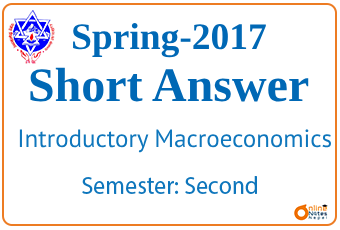Published by: Dikshya
Published date: 08 Sep 2023

1. What is macroeconomics?
- Macroeconomics is a branch of economics that focuses on the study of the overall economy and its aggregates, such as the total output of goods and services (Gross Domestic Product or GDP), the level of employment and unemployment, the price level, and overall economic growth.
2. What are the leakages and injections in the circular flow model?
- In the circular flow model of the economy, Leakages include savings, taxes, and imports, as they represent money that leaves the circular flow of income. Injections include investment, government spending, and exports, as they represent money that enters the circular flow of income.
3 .What is the essence of say’s law of market?
- Say's Law of Market, proposed by Jean-Baptiste Say, suggests that "supply creates its own demand.
4 .The value of MPC lies between 0 and 1. Justify.
- The Marginal Propensity to Consume (MPC) is a measure of how much additional income a household or individual is likely to spend rather than save. The value of MPC lies between 0 and 1 because individuals and households typically consume a portion of any additional income they receive but also save a portion
5 .State the Keynes’s psychological law of consumption.
- Keynes's psychological law of consumption states that as income increases, people tend to consume more but at a decreasing rate. In other words, the higher the income, the smaller the proportion of it that people are inclined to spend.
6. Define the consumption and saving equations.
- The consumption equation represents the relationship between consumption (C), income (Y), and the marginal propensity to consume (MPC):
C = MPC * Y
The saving equation represents the relationship between saving (S), income (Y), and the marginal propensity to save (MPS):
S = MPS * Y
Where:
7. Write any four characteristics of depression phase of business cycle.
- Characteristics of the depression phase of the business cycle include:
a. High unemployment rates.
b. Decreased consumer and business spending.
c. Falling GDP and economic output.
d. Declining business investment and confidence.
8 .Mention the instruments of monetary policy.
- Instruments of monetary policy include:
a. Open market operations (buying and selling government securities).
b. Discount rates (interest rates at which banks borrow from the central bank).
c. Reserve requirements (the amount of money banks must hold in reserve).
9. What type of fiscal policy is considered as expansionary fiscal policy?
- Expansionary fiscal policy involves government actions aimed at increasing aggregate demand and stimulating economic growth.
10. Define inflationary gap.
- An inflationary gap is a situation where the actual level of aggregate demand in an economy exceeds its potential output or full employment level. This leads to upward pressure on prices and inflation.